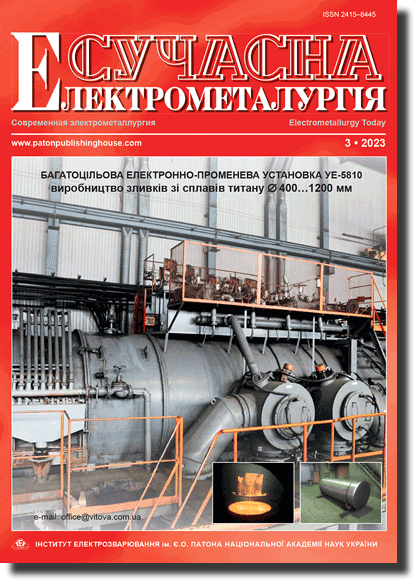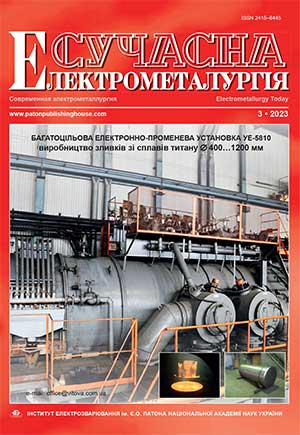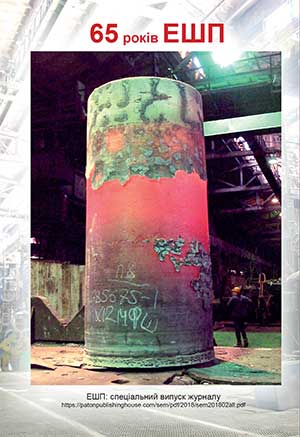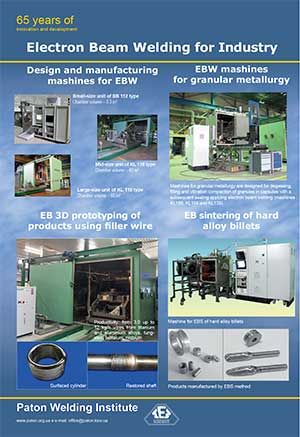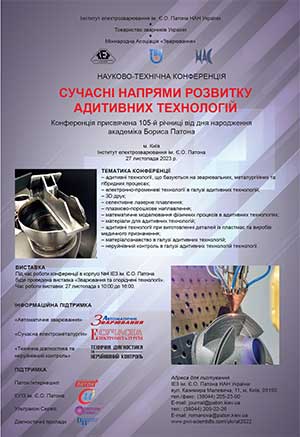| 2023 №03 (06) |
DOI of Article 10.37434/sem2023.03.07 |
2023 №03 (01) |
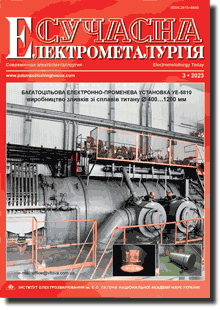
"Suchasna Elektrometallurgiya" (Electrometallurgy Today), 2023, #3, 48-55 pages
Manufacturing technologies of Cu‒Al bimetallic composites (Review)
I.V. Ziakhor1, A.O. Nakonechnyi1, Wang Qichen2, Linyu Fu3, V.V. Koltsov4
1E.O. Paton Electric Welding Institute of the NAS of Ukraine. 11 Kazymyr Malevych Str., 03150, Kyiv, Ukraine. E-mail: office@paton.kiev.ua2CIMC Offshore Engineering Institute Company Limited, Yantai, Shandong, P.R. China
3Yantai Fisend Bimetal Co. Limited, Yantai, Shandong, P.R. China
4Enterprise Technologies LTD. 1U Starosilska Str., 02125, Kyiv, Ukraine
Abstract
Copper-aluminium composites are widely used in the power transmission, telecommunications, aviation, automotive and electronics industries. The review is devoted to the analysis of manufacturing technologies of bimetallic copper-aluminium composites. It is shown that two metallurgical methods for the production of Cu‒Al composite blanks have been used — continuous casting with vertical core filling and continuous casting (VCFC) with horizontal core filling (HCFC). The last of the methods is most suitable for industrialization. The features of phase transformations at the Cu/ Al interface during casting of bimetallic composites, their thermomechanical deformation, and welding are considered. It is shown that the interface between the Al-core and the Cu-shell is a multilayer structure consisting of layers of phases γ1(Cu9Al4), δ(Cu3Al2), η2(CuAl), ε2(Cu3Al2+x), θ(CuAl2), and eutectic α(Al)/θ(CuAl2) layers. For the production of copper- clad aluminium (CCA) wire from bimetallic blanks, methods of rolling, drawing and welding are used. The final goal of the review is to determine the initial data and technical solutions for the development of an effective technology for butt welding of copper-aluminium blanks in the production of CCA composites. 32 Ref., 1 Tabl., 6 Fig.
Keywords: copper-aluminum composite, copper-clad aluminum, continuous casting, Cu/Al interface, intermetallic layer, eutectic
Received 31.08.2023
References
1. ISO 13832:2013: Aerospace - wire, aluminium alloy and copper-clad aluminium conductors - general performance requirements.2. ASTM B566-04a(2021): Standard specification for copper-clad aluminium wire. DOI: https://doi.org/10.1520/B0566-04AR21/
3. Liu T., Liu P., Wang Q.D. (2013) Research progress on copper/ aluminium bimetal composite. Mater. Rev., 27(19), 1.
4. Liu S.Y., Wang A.Q., Lyu S.J., Tian H.W. (2018) Interfacial properties and further processing of Cu/Al laminated composite: A review. Mater. Rev., 32(5) 828.
5. Jingpei Xie,, Aixia Mao, Wenyan Wang (2018) Study on interface structure of Cu/Al clad plates by roll Casting Qinghua Chang. Metals, 8, 770. https://doi.org/10.3390/met8100770
6. WANG Qudong, JIANG Haiyan (2020) New research progress on copper/aluminium bimetallic composites LIU Guoping. Material Reports A, 34(4). DOI: https://doi.org/10.11896/cldb.19050192
7. Chu Di, Jianyun Zhang, Jin-jinYAO et al. (2017) Cu-Al interfacial compounds and formation mechanism of copper cladding aluminium composites. Transact. of Nonferrous Metals Society of China, 1 November, 2521-2528. https://doi.org/10.1016/S1003-6326(17)60279-6
8. Jianjun Zhu, Guangkai Yu, Ting Liu et al. (2018) Application of copper cladding aluminium composites in UHV portable earthing and short-circuiting wires. MATEC Web of Conf., 160(3):01004. https://doi.org/10.1051/matecconf/201816001004
9. Ya-Jun Su, Xin-Hua Liu, Hai-You Huang et al. (2011) Interfacial microstructure and bonding strength of copper cladding aluminium rods fabricated by horizontal core-filling continuous casting. Metallurgical and Materials Transact. A, 42A(12), 4088-4099. https://doi.org/10.1007/s11661-011-0785-x
10. Jun Wang, Fan Zhao, Guoliang Xie et al. (2022) Hot compressive deformation of eutectic Al-17 at.% Cu alloy on the interface of the Cu-Al composite plate produced by horizontal continuous casting. Inter. J. of Minerals, Metallurgy and Materials. 29(8), 1578-1588. https://doi.org/10.1007/s12613-021-2276-4
11. Hanyan Lia, Wenge Chena, Longlong Donga et al. (2018) Interfacial bonding mechanism and annealing effect on Cu-Al joint produced by solid-liquid compound casting. J. of Materials Proc. Technology, 252(2), 795-803. https://doi.org/10.1016/j.jmatprotec.2017.10.050
12. Zhiping Mao, Jingpei Xie, IAiqin Wang et al. (2018) Interfacial characterization and bonding properties of copper/aluminium clad sheets processed by horizontal twin-roll casting, multi-pass rolling, and annealing. Metals., 645(8), 1-17. https://doi.org/10.3390/met8080645
13. Ying Fu, Yubo Zhang, Jinchuan Jie et al. (2017) Interfacial phase formation of Al-Cu bimetal by solid-liquid casting method. China Foundry, 14(3), 194-198. https://doi.org/10.1007/s41230-017-6057-7
14. Yubo Zhang, Ying Fu, Jinchuan Jie et al. (2017) Characteristics of copper-clad aluminium rods prepared by horizontal continuous casting. Metals and Materials Inter., 23, 1197-1203. https://doi.org/10.1007/s12540-017-6922-3
15. Liu Xinhua, Fu Huadong, He Xingqun et al. (2018) Numerical simulation analysis of continuous casting cladding forming for Cu-Al composites. Acta Metallurgica Sinica, 54(3), 470-484.
16. Gubbels G.H.M., Kouters M.H.M., Dos Santos Ferreira O. (2012) Characterization of intermetallic compounds in Cu-Al ball bonds: Thermo-mechanical properties, interface delamination and corrosion. Proc. of 4th Conf. on Electronic System-Integration Technology (17-20 September 2012). https://doi.org/10.1109/ESTC.2012.6542123
17. Hyoung Joon Kim, Joo Yeon Lee, Kyung-Wook Paik et al. (2003) Effects of Cu/Al intermetallic compound (IMC) on copper wire and aluminium pad bondability. IEEE Transact. on Components and Packaging Technologies, 26(2), JUNE, 367-374. https://doi.org/10.1109/TCAPT.2003.815121
18. Zyakhor I.V. and Kuchuk-Yatsenko S.I. (2001) Peculiarities of formation of friction welded joints between copper and aluminium. The Paton Welding J., 9, 24-29.
19. Zyakhor I.V. (2000) Peculiarities of friction welding of dissimilar metals and alloys. The Paton Welding J., 5, 36-44.
20. Kuchuk-Yatsenko S.I., Zyakhor I.V., Gordan G.N. (2002) Effect of process parameters and braking dynamics in friction welding on structure and properties of joints between copper and aluminium. The Paton Welding J., 6, 2-7.
21. Kuchuk-Yatsenko S.I., Zyakhor I.V. (2002) Mechanism of bimetal joints formation in friction welding The Paton Welding J., 7, 2-9.
22. Kuchuk-Yatsenko S.I., Zyakhor I.V., Nakonechny A.A. (2018) Resistance butt welding of titanium aluminide γ-TiAl with VT5 alloy. The Paton Welding J., 9, 2-6. https://doi.org/10.15407/tpwj2018.09.01
23. Kuchuk-Yatsenko S.I., Havrysh V.S., Rudenko P.M. et al. (2019) Development of resistance butt welding technology and prototype equipment for joining carbide bar chain ripper teeth of VK-8 material. Sci. Innov., 15(1), 72-81. https://doi.org/10.15407/scine15.01.072
24. Shvets V.I., Didkovskyi O.V., Antipin Ye.V. et al. (2022) Features of microstructure of joints of hypereutectoid AREAL-136HE-X rail steel in flash-butt welding. The Paton Welding J., 3, 34-40. https://doi.org/10.37434/as2022.03.03
25. Kuchuk-Yatsenko S.I., Rudenko P.M., Gavrish V.S. et al. (2020) Operational control as a means of the evaluation of quality of welded connections for flash-butt welding of modern high-strength steels. Sci. Innov., 16(2), 66-71. https://doi.org/10.15407/scine16.02.066
26. Kuchuk-Yatsenko S.I., Hushchyn K.V., Ziakhor I.V. et al. (2021) Structure and mechanical properties of 2219-T87 aluminium alloy joints produced by flash butt welding The Paton Welding J., 8, 27-32. https://doi.org/10.37434/tpwj2021.08.06
27. Gushchin K.V. Ziakhor I.V., Samotryasov S.M. et al. (2022) Peculiarities of flash butt welding of aluminium alloys with resistance preheating using an intermediate insert. The Paton Welding J., 10, 18-24. https://doi.org/10.37434/tpwj2022.10.03
28. Sergeeva Yu.A., Chudakov V.A., Gordan G.N. (1989) Investigation of the transition zone in copper-aluminum joints made by magnetic pulse welding. Avtomatich. Svarka, 12, 5-8.
29. Markashova L.I., Sergeeva Yu.A., Statsenko V.V. et al. (1991) Features of the structure formation mechanism under the conditions of magnetic pulse welding. Avtomatich. Svarka, 3, 21-26.
30. Polieshchuk M.A., Matveiev I.V., Bovkun V.O. et al. (2020) Application of magnetic-pulse welding to join plates from similar and dissimilar alloys. The Paton Welding J., 8, 41-45. https://doi.org/10.37434/tpwj2020.08.07
31. Dobrushin L.D., Bryzgalin A.G., Shlonskii P.S. et al. (2012) Combined explosive cladding/drawing technology for production of coaxial Cu-Al electric conductors for aerospace application. Proc. of Inter. Сonf. on Explosive Production of New Materials (May 2-5, Strasbourg, France, 2012), 35.
32. Bryzgalin A.G., Pekar E.D., Shlonskiy P.S., Tsarenko L.V. (2020) Improvement of service properties of metal structures by explosion treatment. The Paton Welding J., 8, 29-33. https://doi.org/10.37434/tpwj2020.08.051
Advertising in this issue:
The cost of subscription/purchase order journals or individual articles
| Journal/Currency | Annual Set | 1 issue printed |
1 issue |
one article |
| TPWJ/USD | 384 $ | 32 $ | 26 $ | 13 $ |
| TPWJ/EUR | 348 € | 29 € | 24 € | 12 € |
| TPWJ/UAH | 7200 UAH | 600 UAH | 600 UAH | 280 UAH |
| AS/UAH | 1800 UAH | 300 UAH | 300 UAH | 150 UAH |
| AS/USD | 192 $ | 32 $ | 26 $ | 13 $ |
| AS/EUR | 180 € | 30 € | 25 € | 12 € |
| SEM/UAH | 1200 UAH | 300 UAH | 300 UAH | 150 UAH |
| SEM/USD | 128 $ | 32 $ | 26 $ | 13 $ |
| SEM/EUR | 120 € | 30 € | 25 € | 12 € |
| TDNK/UAH | 1200 UAH | 300 UAH | 300 UAH | 150 UAH |
| TDNK/USD | 128 $ | 32 $ | 26 $ | 13 $ |
| TDNK/EUR | 120 € | 30 € | 25 € | 15 € |
AS = «Automatic Welding» - 6 issues per year;
TPWJ = «PATON WELDING JOURNAL» - 12 issues per year;
SEM = «Electrometallurgy Today» - 4 issues per year;
TDNK = «Technical Diagnostics and Non-Destructive Testing» - 4 issues per year.





